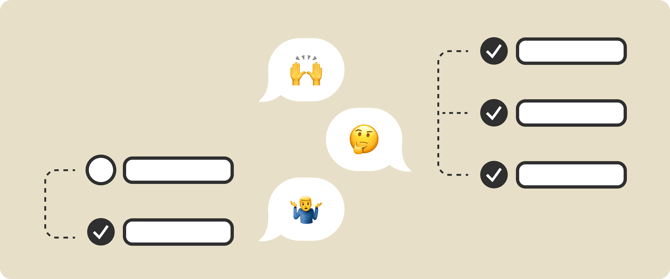Exclusive online summit
·
May 23 2024
Moments that matter: how to seed great work
What's in this article
Whether we’re shopping for a pair of shoes or looking for a new restaurant to try, chances are we’ll want to read some reviews and see what others have to say about the product or experience first. This kind of feedback can either do wonders for reputation, or point out issues where there’s room for improvement.
The same goes for employers. Why would someone want to work for your company? What are others saying about it? Do employees feel seen and heard? Are there opportunities for career growth? And the list goes on. When the employee experience is a positive one, you get retention, much like a store or restaurant gets repeat business and customer loyalty.
But staying engaged doesn’t happen on its own. It stems from a continuous communication loop, checking in, gathering feedback, and acting on it to ensure employees feel happy, valued, and motivated at work. From the moment an employee is onboarded, until the moment they leave the company, it’s important to collect valuable feedback at every step of their employment journey.
With only 32% of U.S. employees feeling engaged at work in 2022, it clearly shows a gap in communication and expectations between employees and their managers. If they don’t have the opportunity to express their needs and gripes, how can there be positive, effective change?
Granted, gathering employee feedback can be challenging as HR and managers of course want to implement best practices, but don't always know where to start. But once you find a strategy that includes the kind of questions to ask, the frequency at which to ask them, and what to do with the answers, you’ll be well on your way to having employees who feel more engaged.
And this process should start at the very beginning of their employment journey, during the onboarding period. Read on to learn how to collect feedback, ask useful questions, create a more positive employee experience, and learn what to do with the feedback in order to improve the onboarding process!
From first impressions to fostering feedback
They say that you never get a second chance to make a first impression. That’s why the onboarding process really sets the tone for the kind of culture and environment an employee can expect to be a part of, especially since only 12% of employees say their company does a good job of onboarding, according to Gallup, meaning there are plenty of opportunities for improvement.
At the foundation, it starts with creating an environment that fosters feedback. This means:
1. Making feedback part of the routine
Gone are the days of annual performance reviews only. It's all about the monthly and weekly check-ins, as well as frequent informal conversations that make gathering feedback feel more natural. Incorporate systematic feedback tools to make this process even more well-rounded.
💡Tip: In Softstart, you can automatically set-up weekly or monthly check-ins to collect feedback in 1-1, but also automate it by collecting feedback on each onboarding activity or with pre-built surveys. And... it's free!
2. Leaving judgment at the door
If you want to receive meaningful feedback, you have to allow employees to feel comfortable giving it. Make it a safe space, free of judgment, and you'll build trust and get more honest feedback (trust us!)
3. Giving positive feedback for accomplishments
It's all about giving credit where credit is due. If someone is doing great work, tell them. Celebrate the little wins as well as the big, and your employees will feel more valued and motivated to do good work.
4. Having honest feedback sessions with your team
A great way to integrate new hires into the team and give them a feel for the kind of feedback culture your company has is to have group discussions. It not only normalizes manager-employee feedback and peer-to-peer feedback, but it also helps strengthen bonds within the team.
5. Giving feedback in real time and following-up one on one
Providing feedback in the moment is especially helpful for new hires. Any extra guidance while settling into their position helps set them on course for success. Following up lets managers build authentic connections with them (and everyone!) by showing your team that you value their feedback.
6. Being crystal clear about expectations and goals
Without a map, you’re bound to get lost. When people are clear on what they are supposed to be doing, they’re better equipped to do it well. This is especially true during onboarding to ensure that new hires are aligned and clear on their role as an individual, and on their team.
Want great feedback? Ask great questions
Want great feedback? Ask great questions
When it comes to asking for employee feedback, it’s best to try and gather qualitative feedback. More in-depth answers give employers better insights into what’s working well, and what’s not. This kind of feedback is crucial for fine-tuning the onboarding process and ensuring employees are happy in the long run. Open-ended questions are a great way to gather this kind of valuable feedback. Here are some examples that you can integrate into your onboarding strategy:
- Are you clear about your responsibilities and what’s expected of you in your new role?
- Is this role what you expected it to be within the company?
- Do you have all the tools and resources you need to perform your job successfully?
- Are people responsive when you ask for help?
- Did you easily get access to all documents and resources you needed?
- How are you feeling now about next week?
- What is the biggest challenge you’ve experienced so far?
- How can we support you in doing a great job?
- Which part of the onboarding process was most helpful for you?
- Which parts of the onboarding process do you think we can improve?
💡Tip: If you want to get the most feedback and useful information, ask open-ended questions that will require a detailed answer. When it's possible, try to avoid the questions that could be answered by simply yes or no.
Leveraging answers to questions like these serves to guide you in improving the onboarding process, making the employee experience even better, and highlighting any missed opportunities to get employees off on the right foot and stay aligned.
For example, if the employee shares that the role is different than they expected, then you know that you need to improve communication and clarify expectations during the onboarding process. If they say they need more support or different tools, it enables you to ensure all future (and current) employees are properly equipped with what they need to do their job the best they can.
In the end, alignment comes from having clear expectations and goals, so onboarding is the perfect time to introduce both personal and team goals that will provide newcomers with a clear path to follow.
Kick things off on the right foot
Workleap Onboarding can help you come out of the gate prepared for smooth onboarding, and help newcomers understand the company, experience the culture, train for their new role, find documents, install their tools, meet their teammates, and pretty much anything else that helps make the process easier. And it’s customizable to your company’s specific needs. Now we might be biased, but we think that’s worth a 5-star rating!



